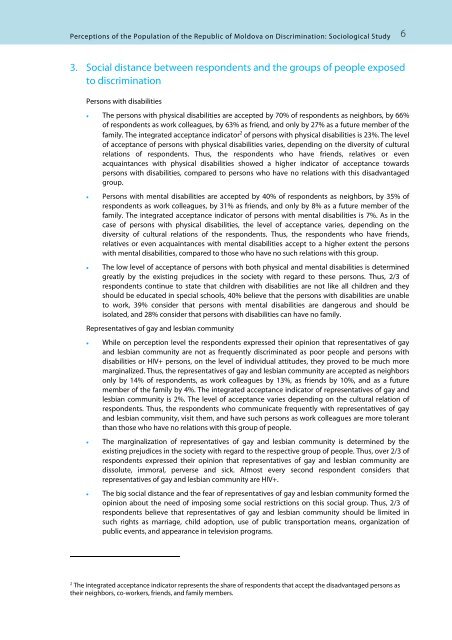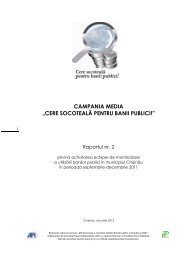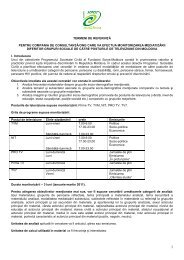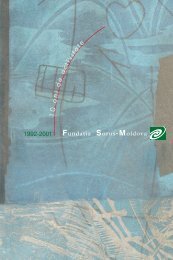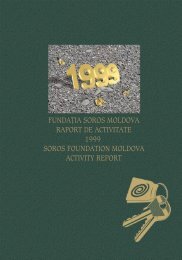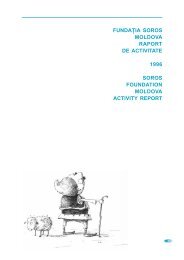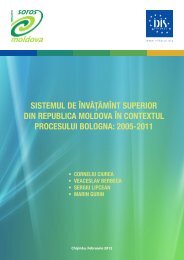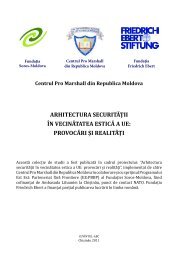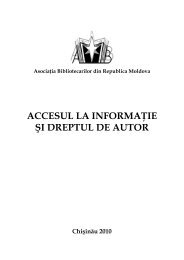Perceptions of the Population of the Republic of Moldova - Soros ...
Perceptions of the Population of the Republic of Moldova - Soros ...
Perceptions of the Population of the Republic of Moldova - Soros ...
- No tags were found...
Create successful ePaper yourself
Turn your PDF publications into a flip-book with our unique Google optimized e-Paper software.
<strong>Perceptions</strong> <strong>of</strong> <strong>the</strong> <strong>Population</strong> <strong>of</strong> <strong>the</strong> <strong>Republic</strong> <strong>of</strong> <strong>Moldova</strong> on Discrimination: Sociological Study 63. Social distance between respondents and <strong>the</strong> groups <strong>of</strong> people exposedto discriminationPersons with disabilities• The persons with physical disabilities are accepted by 70% <strong>of</strong> respondents as neighbors, by 66%<strong>of</strong> respondents as work colleagues, by 63% as friend, and only by 27% as a future member <strong>of</strong> <strong>the</strong>family. The integrated acceptance indicator 2 <strong>of</strong> persons with physical disabilities is 23%. The level<strong>of</strong> acceptance <strong>of</strong> persons with physical disabilities varies, depending on <strong>the</strong> diversity <strong>of</strong> culturalrelations <strong>of</strong> respondents. Thus, <strong>the</strong> respondents who have friends, relatives or evenacquaintances with physical disabilities showed a higher indicator <strong>of</strong> acceptance towardspersons with disabilities, compared to persons who have no relations with this disadvantagedgroup.• Persons with mental disabilities are accepted by 40% <strong>of</strong> respondents as neighbors, by 35% <strong>of</strong>respondents as work colleagues, by 31% as friends, and only by 8% as a future member <strong>of</strong> <strong>the</strong>family. The integrated acceptance indicator <strong>of</strong> persons with mental disabilities is 7%. As in <strong>the</strong>case <strong>of</strong> persons with physical disabilities, <strong>the</strong> level <strong>of</strong> acceptance varies, depending on <strong>the</strong>diversity <strong>of</strong> cultural relations <strong>of</strong> <strong>the</strong> respondents. Thus, <strong>the</strong> respondents who have friends,relatives or even acquaintances with mental disabilities accept to a higher extent <strong>the</strong> personswith mental disabilities, compared to those who have no such relations with this group.• The low level <strong>of</strong> acceptance <strong>of</strong> persons with both physical and mental disabilities is determinedgreatly by <strong>the</strong> existing prejudices in <strong>the</strong> society with regard to <strong>the</strong>se persons. Thus, 2/3 <strong>of</strong>respondents continue to state that children with disabilities are not like all children and <strong>the</strong>yshould be educated in special schools, 40% believe that <strong>the</strong> persons with disabilities are unableto work, 39% consider that persons with mental disabilities are dangerous and should beisolated, and 28% consider that persons with disabilities can have no family.Representatives <strong>of</strong> gay and lesbian community• While on perception level <strong>the</strong> respondents expressed <strong>the</strong>ir opinion that representatives <strong>of</strong> gayand lesbian community are not as frequently discriminated as poor people and persons withdisabilities or HIV+ persons, on <strong>the</strong> level <strong>of</strong> individual attitudes, <strong>the</strong>y proved to be much moremarginalized. Thus, <strong>the</strong> representatives <strong>of</strong> gay and lesbian community are accepted as neighborsonly by 14% <strong>of</strong> respondents, as work colleagues by 13%, as friends by 10%, and as a futuremember <strong>of</strong> <strong>the</strong> family by 4%. The integrated acceptance indicator <strong>of</strong> representatives <strong>of</strong> gay andlesbian community is 2%. The level <strong>of</strong> acceptance varies depending on <strong>the</strong> cultural relation <strong>of</strong>respondents. Thus, <strong>the</strong> respondents who communicate frequently with representatives <strong>of</strong> gayand lesbian community, visit <strong>the</strong>m, and have such persons as work colleagues are more tolerantthan those who have no relations with this group <strong>of</strong> people.• The marginalization <strong>of</strong> representatives <strong>of</strong> gay and lesbian community is determined by <strong>the</strong>existing prejudices in <strong>the</strong> society with regard to <strong>the</strong> respective group <strong>of</strong> people. Thus, over 2/3 <strong>of</strong>respondents expressed <strong>the</strong>ir opinion that representatives <strong>of</strong> gay and lesbian community aredissolute, immoral, perverse and sick. Almost every second respondent considers thatrepresentatives <strong>of</strong> gay and lesbian community are HIV+.• The big social distance and <strong>the</strong> fear <strong>of</strong> representatives <strong>of</strong> gay and lesbian community formed <strong>the</strong>opinion about <strong>the</strong> need <strong>of</strong> imposing some social restrictions on this social group. Thus, 2/3 <strong>of</strong>respondents believe that representatives <strong>of</strong> gay and lesbian community should be limited insuch rights as marriage, child adoption, use <strong>of</strong> public transportation means, organization <strong>of</strong>public events, and appearance in television programs.2The integrated acceptance indicator represents <strong>the</strong> share <strong>of</strong> respondents that accept <strong>the</strong> disadvantaged persons as<strong>the</strong>ir neighbors, co-workers, friends, and family members.


